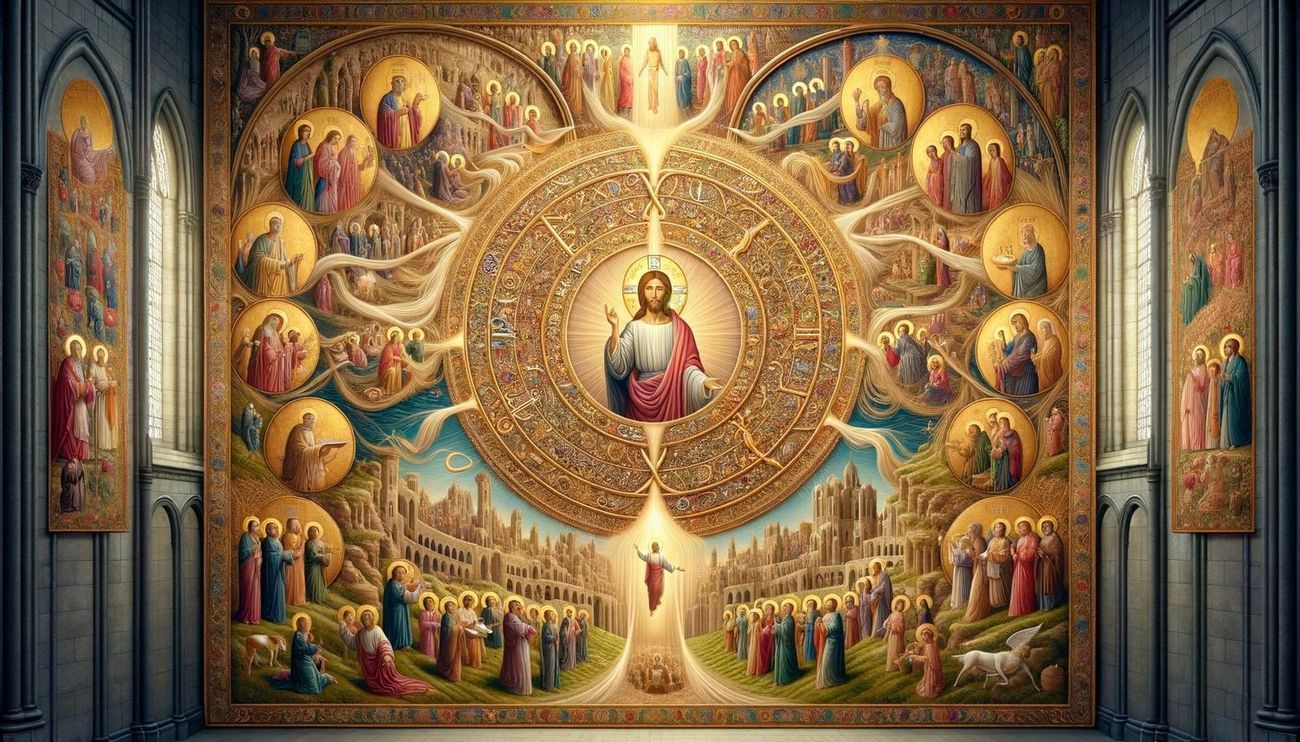Home>Christian Videos>Bible Stories>What Does Harmony Of The Gospels Mean


Bible Stories
What Does Harmony Of The Gospels Mean
Published: March 7, 2024
Jason DeRose, Managing Editor at Christian.net, uses his expertise in religion and journalism to deepen understanding of faith's societal impacts. His editorial leadership, coupled with a strong academic background, enriches the platform’s diverse content, earning him recognition in both journalism and religious circles.
Discover the meaning of Harmony of the Gospels and explore the fascinating Bible stories that intertwine to create a cohesive narrative. Delve into the harmonious blend of the Gospels and their impact on biblical understanding.
(Many of the links in this article redirect to a specific reviewed product. Your purchase of these products through affiliate links helps to generate commission for Christian.net, at no extra cost. Learn more)
Table of Contents
Introduction
What does harmony of the Gospels mean? The harmony of the Gospels refers to the process of comparing and reconciling the accounts of the life, teachings, death, and resurrection of Jesus Christ as presented in the four canonical Gospels of the New Testament: Matthew, Mark, Luke, and John. This process seeks to create a unified and comprehensive narrative that incorporates the unique perspectives and details provided by each Gospel writer. The harmonization of the Gospels is a significant aspect of biblical scholarship and is essential for gaining a deeper understanding of the life and ministry of Jesus Christ.
Understanding the Synoptic Gospels
The term "Synoptic Gospels" refers to the first three Gospels of the New Testament: Matthew, Mark, and Luke. These Gospels are considered "synoptic" because they share a significant amount of common material, including similar stories, teachings, and events in the life of Jesus. The word "synoptic" is derived from the Greek words "syn," meaning together, and "opsis," meaning seeing. This term reflects the shared perspective and content of these three Gospels.
The Synoptic Gospels are often studied together due to their structural and thematic similarities. Scholars believe that the Gospel of Mark was the first to be written, serving as a primary source for both Matthew and Luke. This shared source is known as the "Q" document, which contains the sayings of Jesus that are common to Matthew and Luke but not found in Mark. The Synoptic Gospels provide a comprehensive portrayal of the life and teachings of Jesus, offering valuable insights into his ministry and the early Christian community.
Key characteristics of the Synoptic Gospels include their focus on the teachings and miracles of Jesus, as well as the events leading up to his crucifixion and resurrection. While each Gospel writer presents these elements from their unique perspective, the Synoptic Gospels collectively contribute to a cohesive narrative of Jesus' life and mission. Understanding the Synoptic Gospels is essential for exploring the harmony of the Gospels and comprehensively interpreting the message of the New Testament.
Exploring the Differences and Similarities
-
Differences in Emphasis: Each Gospel writer emphasizes different aspects of Jesus' life and teachings. For example, Matthew highlights Jesus as the fulfillment of Old Testament prophecies, presenting him as the long-awaited Messiah. Mark, on the other hand, portrays Jesus as a powerful and authoritative figure, focusing on his miracles and deeds. Luke emphasizes Jesus' compassion for the marginalized and downtrodden, while John delves deeply into the divinity of Christ, emphasizing his eternal nature and divine identity.
-
Chronological Variances: The Gospels often present events in a different chronological order. While this may seem like a discrepancy, it is essential to understand that the Gospel writers arranged their accounts to serve specific theological and narrative purposes. For instance, the placement of certain teachings or miracles may differ between the Gospels, reflecting the author's intent to convey a particular message or theme.
-
Unique Details and Perspectives: Each Gospel contains unique details and perspectives that enrich the overall portrayal of Jesus' life. For instance, the Gospel of John includes distinct discourses and conversations not found in the Synoptic Gospels. Additionally, the Gospel of Luke provides extensive details about the birth and early life of Jesus, offering a perspective not covered in the other Gospels.
-
Common Themes and Overlapping Accounts: Despite the differences, the Gospels share common themes and contain overlapping accounts of significant events. The accounts of Jesus' crucifixion and resurrection are central to all four Gospels, albeit with varying details and perspectives. The shared themes of love, redemption, and the establishment of God's kingdom are woven throughout the narratives, underscoring the unity of the Gospels in conveying the core message of Christianity.
-
Cultural and Linguistic Context: The differences and similarities in the Gospels are also influenced by the cultural and linguistic context in which they were written. Each Gospel reflects the unique cultural milieu and linguistic nuances of its author, contributing to the diverse portrayals of Jesus and his teachings.
Exploring the differences and similarities among the Gospels provides a comprehensive understanding of the multifaceted nature of Jesus' life and ministry. It underscores the richness of the biblical narrative and the diverse perspectives that collectively contribute to the harmonized portrayal of the central figure of Christianity.
The Importance of Harmonizing the Gospels
-
Comprehensive Understanding: Harmonizing the Gospels is crucial for gaining a comprehensive understanding of the life, teachings, and significance of Jesus Christ. By comparing and reconciling the accounts presented in the four Gospels, scholars and readers can construct a more complete narrative that incorporates the unique perspectives and details provided by each Gospel writer. This process allows for a deeper exploration of the cultural, historical, and theological contexts in which the Gospels were written, enriching the interpretation of Jesus' ministry and its impact on the early Christian community.
-
Preservation of Diverse Perspectives: The harmonization of the Gospels preserves the diverse perspectives and emphases of the Gospel writers while highlighting the unity of the overarching message. Each Gospel contributes distinct insights into the person and work of Jesus, reflecting the multifaceted nature of his identity and mission. By harmonizing the Gospels, readers can appreciate the richness of the biblical narrative and the varied portrayals of Jesus that collectively convey the essence of Christian faith.
-
Corroboration of Historical Events: Harmonizing the Gospels aids in corroborating the historical events and teachings attributed to Jesus. While the Gospels may present certain events from different vantage points, the process of harmonization allows for the alignment of key events and teachings, reinforcing their historical authenticity. This corroborative approach strengthens the credibility of the Gospel accounts and provides a more robust foundation for understanding the life and impact of Jesus within the historical context of the first century.
-
Facilitation of In-Depth Study: The harmonization of the Gospels facilitates in-depth study and analysis of the biblical text. By comparing parallel passages and harmonizing the details, scholars and readers can delve into the nuances of the Gospel narratives, discerning the theological themes, literary structures, and cultural influences that shape the presentation of Jesus' ministry. This comprehensive approach to studying the Gospels enhances the exegetical and hermeneutical exploration of the New Testament, fostering a deeper appreciation of the biblical message.
-
Unity in Diversity: Harmonizing the Gospels underscores the unity of the Christian faith while embracing the diversity of the Gospel accounts. It emphasizes the interconnectedness of the four Gospels, demonstrating how their collective testimony forms a cohesive and harmonized portrayal of Jesus Christ. This unity in diversity serves to strengthen the foundational beliefs of Christianity and reinforces the significance of Jesus' life, death, and resurrection as central tenets of the Christian faith.
The importance of harmonizing the Gospels extends beyond scholarly pursuits, as it directly impacts the interpretation, understanding, and proclamation of the Christian message. By recognizing the significance of harmonization, individuals can engage with the Gospels in a more holistic and informed manner, deepening their appreciation of the profound impact of Jesus Christ on human history and spirituality.
Methods of Harmonizing the Gospels
-
Parallel Comparison: One method of harmonizing the Gospels involves conducting a parallel comparison of similar passages across the four accounts. By aligning parallel passages and identifying shared details, scholars can create a unified narrative that integrates the distinct perspectives of each Gospel writer. This approach allows for the synthesis of complementary details and the construction of a comprehensive portrayal of the events and teachings of Jesus.
-
Chronological Alignment: Harmonizing the Gospels through chronological alignment involves arranging the events and teachings of Jesus in a cohesive timeline. While the Gospels may present certain events in different sequences, this method seeks to reconcile the chronological variances by establishing a harmonized timeline of Jesus' ministry. By aligning the chronological details, scholars can create a synchronized framework that accounts for the diverse narrative structures of the Gospels.
-
Thematic Integration: Another method of harmonization involves thematic integration, wherein scholars identify common themes and theological motifs present in the Gospels. By tracing recurring themes such as the kingdom of God, discipleship, and salvation, scholars can harmonize the diverse accounts by emphasizing the shared theological emphases of the Gospel writers. This thematic approach highlights the unity of the Gospels in conveying essential aspects of Jesus' message and mission.
-
Cultural and Historical Contextualization: Harmonizing the Gospels through cultural and historical contextualization involves considering the unique cultural and historical contexts in which each Gospel was written. By understanding the socio-political, religious, and linguistic milieu of the first-century Mediterranean world, scholars can harmonize the Gospels by appreciating the distinct perspectives and emphases shaped by their respective contexts. This contextual approach enriches the harmonization process by acknowledging the diverse influences that contributed to the composition of the Gospels.
-
Textual Criticism and Source Analysis: Scholars employ textual criticism and source analysis to harmonize the Gospels by examining the textual variants and potential sources behind the Gospel accounts. This method involves evaluating the manuscript evidence, linguistic nuances, and potential literary sources to reconcile discrepancies and variations in the Gospel narratives. By critically assessing the textual transmission and sources utilized by the Gospel writers, scholars can harmonize the accounts while discerning the underlying historical and literary dynamics at play.
-
Synoptic Comparison: The method of synoptic comparison focuses on harmonizing the Synoptic Gospels—Matthew, Mark, and Luke—by identifying parallel passages and distinctive details in their accounts. This comparative approach allows scholars to harmonize the Synoptic Gospels by recognizing shared material, unique contributions, and the interplay of literary and narrative elements across the three accounts. Synoptic comparison is instrumental in creating a harmonized synthesis of the Synoptic Gospels' portrayal of Jesus' life and teachings.
Employing these methods of harmonizing the Gospels enables scholars and readers to engage with the rich tapestry of the Gospel narratives, fostering a deeper understanding of the multifaceted portrayal of Jesus Christ and the theological significance of the New Testament accounts.
Read more: What Does It Mean To Be On Lent?
Challenges and Criticisms of Harmonization
-
Textual Variants and Discrepancies: One of the primary challenges in harmonizing the Gospels arises from the presence of textual variants and discrepancies among the manuscript traditions. The diverse copies of the Gospels contain variations in wording, phrasing, and details, leading to challenges in creating a harmonized account. Scholars must carefully navigate through the textual complexities to reconcile the differences and discern the original wording and narrative intent of the Gospel writers.
-
Historical and Literary Context: The diverse historical and literary contexts in which the Gospels were composed present challenges in harmonization. Each Gospel reflects the unique perspectives, theological emphases, and narrative styles of its author, influenced by the cultural and historical milieu of the first-century Mediterranean world. Harmonizing the Gospels requires a nuanced understanding of these contextual factors to appreciate the distinct contributions of each Gospel writer while constructing a unified narrative.
-
Theological and Narrative Intent: Critics of harmonization raise concerns regarding the potential imposition of a singular theological or narrative intent onto the diverse Gospel accounts. The distinct emphases and perspectives of the Gospel writers may be overshadowed by the harmonization process, leading to the loss of their individual contributions. Scholars must address these criticisms by preserving the integrity of each Gospel while seeking to harmonize their accounts in a manner that respects their unique theological and narrative nuances.
-
Ethical and Methodological Considerations: Harmonizing the Gospels necessitates ethical and methodological considerations, particularly in the treatment of textual variants and the selection of harmonization methods. Critics argue that certain harmonization approaches may prioritize specific Gospel accounts over others, potentially leading to biased interpretations and the neglect of alternative perspectives. Scholars must navigate these ethical and methodological challenges to ensure a balanced and comprehensive harmonization process.
-
Diversity of Interpretations: The diversity of interpretations regarding the harmonization of the Gospels poses a significant challenge. Different scholars and religious traditions may approach harmonization from varying perspectives, leading to divergent harmonized narratives and theological implications. Navigating the plurality of interpretations and harmonization methods requires careful consideration of the underlying assumptions, biases, and scholarly frameworks employed in the process.
-
Critical Engagement with Source Material: Engaging critically with the source material, including the Synoptic problem, the potential existence of the Q document, and the interplay of oral tradition and written sources, presents challenges in harmonizing the Gospels. Scholars must grapple with the complexities of source analysis and the transmission of Gospel traditions to construct a harmonized narrative that reflects a judicious assessment of the underlying historical and literary dynamics.
Addressing these challenges and criticisms of harmonization requires a balanced and rigorous approach that respects the diversity of the Gospel accounts while seeking to create a cohesive and comprehensive portrayal of the life and teachings of Jesus Christ. By acknowledging these challenges and engaging with critical perspectives, scholars can enrich the harmonization process and foster a deeper appreciation of the multifaceted nature of the Gospels.
Conclusion
In conclusion, the harmony of the Gospels encompasses a multifaceted process of comparing, reconciling, and synthesizing the accounts of the life, teachings, death, and resurrection of Jesus Christ as presented in the four canonical Gospels of the New Testament. Understanding the Synoptic Gospels, exploring their differences and similarities, and recognizing the importance of harmonization are essential for comprehensively interpreting the message of the New Testament. Employing various methods of harmonization, such as parallel comparison, chronological alignment, thematic integration, and synoptic comparison, enables scholars and readers to engage with the rich tapestry of the Gospel narratives, fostering a deeper understanding of the multifaceted portrayal of Jesus Christ and the theological significance of the New Testament accounts. Despite the challenges and criticisms associated with harmonization, addressing these complexities enriches the harmonization process and fosters a deeper appreciation of the multifaceted nature of the Gospels. Ultimately, the harmony of the Gospels serves as a foundational aspect of biblical scholarship, offering valuable insights into the life, teachings, and significance of Jesus Christ within the historical and theological context of the early Christian community.














